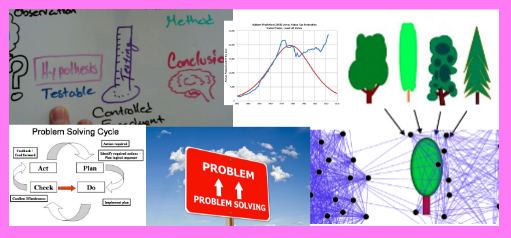


Research on Generating & Testing Hypotheses:
- Hypothesis creating & testing can be approach inductively and deductively.
- deductive thinking – using a general rule to make predictions
- to facilitate this type of thinking, first front load general principles and then ask students to make predictions based on these
- inductive thinking – drawing new conclusions from current evidence
- to facilitate this type of thinking, first get students to generalize evidence and then use those generalizations to make predictions
- this is tricker to pull off than leading deductive thinking because it requires selecting the right experiences and using the right prompts to guide students to effective and accurate generalizations
- real thinking is often a combination of deductive and inductive thinking
- deductive thinking – using a general rule to make predictions
- Students need to clearly explain hypotheses and conclusions
- explain inductive line of reasoning (connecting observations to predictions and conclusions) in written form
Classroom Tips for Generating & Testing Hypotheses:
6 Types of Making / Testing Hypotheses:
- Systems analysis – guide students to think through how a system would change if one aspect of it changed
- students explain parts and purpose of system
- students describe how parts affect each other
- students identify part of systems and describe how changing that part might affect the rest of the system
- students test the hypothesis through experiments or simulations
- Problem solving – selecting solutions that meet specific constraints
- students define the problem or goal
- students describe the problem constraints and challenges
- students identify solutions
- students test solutions – test prototypes or use simulations
- students explain whether hypothesis was correct and whether or not to test new solutions
- Historical investigation – constructing plausible scenarios of past events
- students analyze and describe historical event to be investigated
- students identify what is known about event and what is not known or up to controversy
- students propose a historical scenario
- students research information to test accuracy of historical scenario
- Invention – using knowledge to create new products and solutions
- students identify a need to situation to improve
- students identify standards related to need or improvement
- student brainstorm possible solutions
- student models solutions
- student test models of solutions
- students modify solutions to better meet standards
- Experimental inquiry – using experiments to test hypotheses can be used in science and other subjects
- students make observations
- student apply related theories to explain what was observed
- students used related theories to develop hypotheses that explain observations
- students engage in activity or experiment to test hypothesis
- students explain results of activity or experiment – compare to hypothesis and decide whether to conduct more experiments
- Decision making – hypothesis testing can help with decisions that select things with the most or lest of somethings
- students select a choice and identify its alternatives
- students identify criteria that will be used to make decision
- students use criteria to rate alternatives
- students calculate a weighted sum of each score generated from ratings in previous step
- students use scores to compare alternatives
- students analyze selected alternative and decide whether or not to adjust criteria or weighting factors
Making sure students can explain hypotheses:
- provide templates that guide students to provide acceptable evidence for hypotheses
- use sentence stems
- audio record student explanations of hypotheses
- co-develop and implement rubrics that assess quality of hypotheses and related explanations
- provide public presentation opportunities

Generating and testing hypotheses is a powerful way of developing understanding that is not limited to science classes. The six hypothesis types above demonstrate how hypotheses can be used in disciplines inside and outside of science. Using various processes to make and test different types of hypothesis can teach students how to take intellectual risks and learn from them.

Preparation Steps
- Investigate the types of problem solving involved in applying upcoming content
- Decide which hypothesis model (see above) fits with the problem solving models in upcoming content
- Research, gather, and design strategies and tools that can facilitate student thinking through a specific type of hypothesis making & testing
Early Implementation Steps
- Guide students through making and testing specific types of hypotheses
- Have students reflect on how making and testing hypotheses is affecting their products and understandings
Advanced Implementation Steps
- Have students reflect on how hypothesis testing relates to their own personal lives – especially as it related to goal setting and problem solving
- Guide students through different types of hypothesis testing over various projects – have students compare/contrast their learning experiences while making and testing different types of hypotheses

